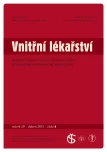Changes in weight and diabetes compensation (HbA1c) in patients with diabetes mellitus type 2 after adding exenatide (Byetta) to the current treatment in 28 diabetology departments in the Czech Republic – BIBY‑II study (observations lasting 24 months)
Authors:
J. Perušičová 1; P. Piťhová 1; I. Haladová 2; A. Pracovní Skupina Diabetologů:; D. Ácsová; J. Bělobrádková; A. Belzová; K. Berková; B. Doležalová; H. Dvořáková; K. Hejnicová; M. Hudcová; D. Kallmünzerová; Z. Krejsová; G. Markofová; H. Müllerová; K. Owen; M. Pelikánová; L. Raclavská; E. Račická; O. Škarpová; A. Váchová; A. Veselá; J. Vyoralová; J. Brož; T. Edelsberger; MUDr. Marek Honka; T. Hrdina; P. Chmura; J. Tošovský
Authors‘ workplace:
Interní klinika 2. lékařské fakulty UK a FN Motol Praha, přednosta prof. MU Dr. Milan Kvapil, CSc., MBA
1; I. interní klinika Lékařské fakulty UK a FN Plzeň, přednosta prof. MU Dr. Martin Matějovič, Ph. D.
2
Published in:
Vnitř Lék 2013; 59(4): 249-255
Category:
Original Contributions
Overview
BIBY‑II study objective:
To obtain experience with long‑term (24 months) exenatide treatment (Byetta) in patients with diabetes mellitus type 2 from a common clinical practice of diabetology departments in the Czech Republic.
Type of observation:
Observational study conducted by a randomly selected group of outpatient medical practitioners from 28 diabetology departments in the Czech Republic.
Observed and assessed population:
From the original population of 465 patients, who underwent a minimum of three month’s Byetta treatment, 169 patients (36.6%) remained during the second prolonged observation after 18 months, and 76 patients completed 24 months of uninterrupted Byetta treatment. The following basic information about the patients was collected: year of birth, sex, age when diabetes mellitus (DM) manifested, height, maximum weight before diabetes and when DM manifested. The study recorded the following values in three- month intervals: weight, waistline, glycated haemoglobin (HbA1c), and DM treatment. The population of the prolonged observation comprised 50.3% women and 49.7 % men, and the average age at the time of DM2 manifestation was 48.0 (20– 73 years).
Results:
At the beginning of Byetta treatment, the average maximum BMI in the sub‑population observed for 24 months was 38.44; after 3, 6, 9, 12 and 24 months the following levels were measured, respectively: 36.79, 36.22, 35.91, 35.57 and 35.58. The original HbA1c level of 7.44% at the beginning of Byetta treatment decreased after 3, 6, 9, 12 and 24 months to 6.33, 5.98, 5.83, 5.86 and 5.93%.
Conclusion:
Adding Byetta to the currently applied treatment of obese patients with diabetes mellitus type 2 over a period of 24 months has led to an improvement in HbA1c level by 1.51%, and BMI level was reduced by 2.37 after two years of Byetta treatment.
Key words:
diabetes mellitus type 2 – change in weight of a diabetic – exenatide – Byetta – BMI – HbA1c
Sources
1. Bergenstal RM, Garrison jr. LP, Wintle M et al. (ExOS): baseline population characteristics of a prospective research study to evaluate the clinical effectiveness of exenatide bid use in patients with type 2 diabetes in a real- world setting. Curr Med Res Opin 2011; 27: 531– 540.
2. Bergenstal RM, Garrison jr. LP, Miller LA et al. Exenatide BID Observational Study (ExOS): results for primary and secondary endpoints of a prospective research study to evaluate the clinical effectiveness of exenatide BID use in patients with type 2 diabetes in a real- world setting. Curr Med Res Opin 2011; 27: 2335– 2342.
3. Levin PA, Mersey JH, Zhou S et al. Clinical outcomes using long‑term combination therapy with insulin glargine and exenatide in patients with type 2 diabetes mellitus. Endocr Pract 2012; 18: 1– 25.
4. Macconell L, Brown C, Gurney K et al. Safety and tolerability of exenatide twice daily in patients with type 2 diabetes: integrated analysis of 5594 patients from 19 placebo- controlled and comparator- controlled clinical trials. Diabetes Metab Syndr Obes 2012; 5: 29– 41.
5. Monami M, Dicembrini I N et al. Effects of Glucagon- Like Peptide- 1 Receptor Agonists on Body Weight: A Meta‑Analysis. Exp Diabetes Res 2012; 2012: 672658.
6. Varanasi A, Chaudhuri A, Dhindsa S et al. Durability of effects exenatide treatment on glycemic control, body weight, systolic pressure, CRP and triglycerides concentrations. Endocr Pract 2010; 14: 1– 20.
Labels
Diabetology Endocrinology Internal medicineArticle was published in
Internal Medicine

2013 Issue 4
Most read in this issue
- Aortic stenosis
- Lung metastases as the first manifestations of occult medullary microcarcinoma
- The „Short Physical Performance Battery“ in the Czech Republic – the pilot and validation study in older persons
- Perindopril in the treatment of hypertension and cardiovascular diseases: evolution continues with the orodispersible dosage form
